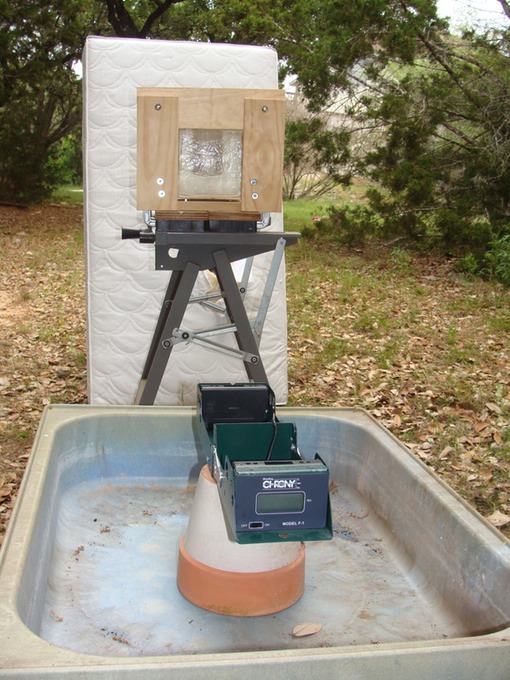I will be testing if I can break the egg inside the ballistics gel, and how much kinetic energy is needed to do it. I will be assuming that all kinetic energy is converted to potential energy on impact. I will also assume that the egg doesn’t affect the overall elastic modulus of the ballistics gel block.
I made a box out of plywood to hold the gel and be clamped down. The slingshot was made using quarter-inch surgical tubing, an old wallet for the pouch, and two trees. The projectile is a 2 inch steel ball that weighs .535kg. The velocity of the ball will be measured with a chronograph just before it impacts the gel.
The steel ball weighs .535kg. I will shoot the ball out of the slingshot, over the chronograph, and into the gel. When I find the point where the egg breaks, I will see the velocity. That and the mass will give us the kinetic energy, which we can assume converts to potential energy. I can then use that and the gel’s elastic modulus to find the deformation of the gel. Then this combined with kinetic energy will give me the force on impact. I will then be able to see if this is anywhere close to the force tested in the egg crusher. (See Detailed Report : Kevlar and Blunt Trauma, §6.5, p. 13 for formulas)
I decided to calibrate my slingshot so that I could more easily do tests at different velocities. To do this I tied a string to the tree that I could mark at the correct distances for the slingshot to fire at a certain velocity. I shot the slingshot over the chronograph until I could consistently match out intended velocity and then marked the string at that distance. This way if I want to fire the ball at 60fps, I can simply pull the slingshot to the 60 mark, and it will fire at that speed.
Results
On the first shot with the slingshot I managed to hit the block in the center at a speed of 48.3fps. The egg broke and everything seemed to work very well. However, the table with the ballistics gel box moved back several inches, meaning that a fair amount of the KE was lost to making it move. This is a problem because I am making the assumption that all of the KE of the ball is being transferred to the ballistics gel block. For the next test I added weights to the front of the table to keep it from moving.
On the second test the slingshot fired at 53.3fps but was slightly off on my aim and clipped the edge of the box before hitting the gel. The egg still broke, but the test is unreliable because the ball would have lost velocity when hitting the box. However the table stayed in place, meaning it is ready for future tests.
I continued taking shots, slowly reducing the speed until I found the speed that would no longer break the egg. Once I found that, at 32.6fps, I could find the absolute minimum force required to break the egg at that depth with just the gel.
I did the same exact thing with the egg 10cm in the gel. I shot it at 72fps and then slowly reduced the speed until the egg would no longer break. I found that the speed when the egg wouldn’t break was right around 57fps.
These tests show me the minimum force on impact required to break an egg at each depth without anything in front of the gel. This gives me a consistent control to compare other tests to. Now when I test with Kevlar sheets in front of the gel I will be able to find the minimum force to break the egg then, and compare that to the gel without Kevlar. This will tell me exactly how much the Kevlar helps.
Movie showing egg break at 10 cm. Ball traveling 72.4 fps
